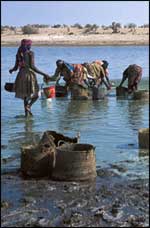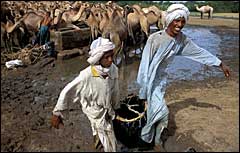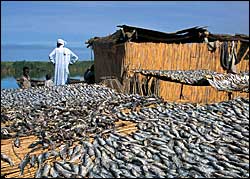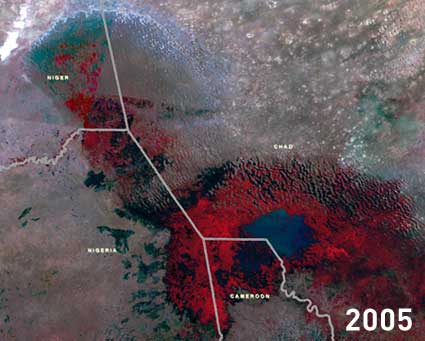Lake Chad, a system under threat
 The shrinking of Lake Chad, which is bordered by 4 African countries (Cameroon, Niger, Nigeria, and Chad), is already an ecological catastrophe but it is fast becoming a very human disaster as well. The 30 million people who live in the lake region are being forced into ever-keener competition for this vital and disappearing resource. The drying-up of the lake water and deterioration of the production capacity of its basin have affected all the socio-economic activities, leading to internal exodus and increased pressure on the natural resources and conflicts between the populations. In addition to the approximately 60% decline in fish production, there has been degradation of pasturelands, leading to shortage of dry matter estimated at 46.5% in certain places in 2006, reduction in the livestock population, and threat to biodiversity.
The shrinking of Lake Chad, which is bordered by 4 African countries (Cameroon, Niger, Nigeria, and Chad), is already an ecological catastrophe but it is fast becoming a very human disaster as well. The 30 million people who live in the lake region are being forced into ever-keener competition for this vital and disappearing resource. The drying-up of the lake water and deterioration of the production capacity of its basin have affected all the socio-economic activities, leading to internal exodus and increased pressure on the natural resources and conflicts between the populations. In addition to the approximately 60% decline in fish production, there has been degradation of pasturelands, leading to shortage of dry matter estimated at 46.5% in certain places in 2006, reduction in the livestock population, and threat to biodiversity.
The situation in the Lake Chad Basin is one of the most important untold stories of recent times. The lake was once one of the largest water bodies on the planet and due to climatic variability, climate change and human pressure on water resources in its basin over recent decades, the lake has shrunk by 90% from 25000 square kms in 1963 to less than 1500 square kilometers in 2001. At the current rate of recession of the water body, the Lake could disappear about twenty years from now, according to climate forecasts of NASA.
 Something must be done urgently to reverse the tragic disappearance of Lake Chad if the livelihoods of this vast area are to be safeguarded. This realization led to the setting up in 1964 of The Lake Chad Basin Commission (LCBC). Representatives of the Lake Chad Basin countries that border the lake meet to regulate and control the utilization of water and other natural resources in the Basin and they, in partnership with the Food and Agriculture Organization of the United Nations and Development Partners are actively seeking new models of Adaptive Water Management that take account of traditional agricultural techniques as well as the need to ensure food security for the people of the region.
Something must be done urgently to reverse the tragic disappearance of Lake Chad if the livelihoods of this vast area are to be safeguarded. This realization led to the setting up in 1964 of The Lake Chad Basin Commission (LCBC). Representatives of the Lake Chad Basin countries that border the lake meet to regulate and control the utilization of water and other natural resources in the Basin and they, in partnership with the Food and Agriculture Organization of the United Nations and Development Partners are actively seeking new models of Adaptive Water Management that take account of traditional agricultural techniques as well as the need to ensure food security for the people of the region.
 There is a realization by the Lake Chad Basin Commission that the diminished flow Photo: FAO foto of water into the lake means that, alongside a radical change in water management techniques, a scheme to replenish the water in Lake Chad is necessary. The flow of the two main sources of replenishment for the lake, the Chari and Logone rivers have decreased significantly in the last 40 years. The Feasibility Study for an ambitious programme to divert water flow from the Oubangui, the major tributary of the Congo River, into the Chari river system will be presented at the Special Event on October 16th.
There is a realization by the Lake Chad Basin Commission that the diminished flow Photo: FAO foto of water into the lake means that, alongside a radical change in water management techniques, a scheme to replenish the water in Lake Chad is necessary. The flow of the two main sources of replenishment for the lake, the Chari and Logone rivers have decreased significantly in the last 40 years. The Feasibility Study for an ambitious programme to divert water flow from the Oubangui, the major tributary of the Congo River, into the Chari river system will be presented at the Special Event on October 16th.


